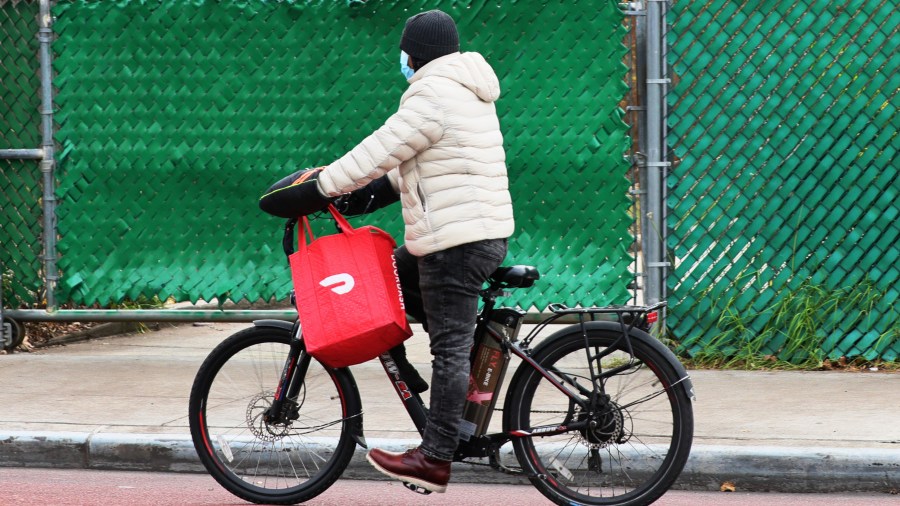What if gig workers could train the algorithms that determine their pay?

A couple of drivers for the delivery app DoorDash may have found a way to trick the algorithm that serves them jobs into offering better pay. Bloomberg profiled their effort, which is called #DeclineNow. They encourage other drivers to decline all the lowest-paid jobs to get the app to offer more money. But to make it work, they need a lot of drivers on board, and that can be tricky with gig workers.
Drivers don’t share a break room, after all. Instead, they’re getting together online in Facebook Groups and on Reddit. I spoke with Lindsey Cameron, a professor of management at the Wharton School who studies gig workers and worked as an Uber driver herself for a while. The following is an edited transcript of our conversation.
Lindsey Cameron: There’s no way for workers to have worker-to-worker communication via the app itself. There’s no Slack or anything like that. So the few times workers are able to connect, it can be in person. I met other ride-hailing drivers when I was at a parking lot, or at the inspection station. And beyond that, it’s usually just these online forums in which only a minority of drivers are active on the forums. But for the people that are on the forums, they’re like the virtual water cooler, where people can share tips, how the platform has changed, things like that.
Meghan McCarty Carino: Now, also, gig workers, instead of having a traditional boss or a supervisor direct their work, they are dictated sort of by algorithms that aren’t always the most transparent. So to what extent are gig workers able to tease out how these algorithms work?
Cameron: As workers, you’re just sort of doing these best guesses about, based on your lived experience, what do you think the surge prices are going to be? Or what do you think is a fair amount to accept for a delivery? And then, you’re sort of guiding, you’re sort of making your own rules about what feels right to you or what’s the best way to respond to the algorithm, based on what you yourself are experiencing through your everyday work.
McCarty Carino: And maybe beyond you yourself, it seems like maybe that’s where sharing information becomes really important in these groups because you may have a hard time with just your own experience of the app, understanding how these kinds of larger patterns are working.
Cameron: Exactly. I mean, if you’re going back to the beginning of the [20th] century, where you’re getting this sort of union power, there’s precursors to that. A lot of this was because workers were able to sort of share experiences in the break rooms or on the shop floor, walking in and out of the assembly line, which would have allowed people to share information and eventually sort of protest and have more humane work practices. And the fact that there’s no organic way as part of the work for individuals to have these communication patterns puts them at a disadvantage on how to share information and sort of how to guesstimate how might the algorithm actually be working, and how they can have the algorithm work more in their favor.
McCarty Carino: So this Decline Now movement that the DoorDash drivers are trying, can this really work?
Cameron: It can work, yes, particularly if you’re in really small areas. These drivers were in the Lehigh Valley, where there’s only a limited number of drivers. I think the question is, how long can that actually work? If these companies bring in a greater supply of drivers, they can decline as much as they want, but there could be new workers coming in. Or maybe the app will somehow change and make it so they won’t offer any orders that are over $7. What I’m trying to say is, of course, these movements can work on the small scale, but they’re not going to have the same effects if we think about these things like strikes and boycotts that really shaped the labor movement. These sort of platform workers, because the work is so decentralized but also very place or geographic dependent, are not going to have the same staying power.
Related links: More insight from Meghan McCarty Carino
Bloomberg, of course, has more about the Decline Now movement, which it reports has attracted about 40,000 gig workers, some of whom are apparently a bit aggressive about shaming other drivers who don’t go along with the plan. And then, there’s the constant influx of new drivers lured by incentives to sign up with the apps, something Uber and Lyft are apparently having to do a lot of these days.
The Financial Times reports the ride-share companies are throwing money at drivers in the U.S. Uber is launching a $250 million fund to attract drivers in what it’s calling a stimulus package because so many left the platform when business tanked during the pandemic and moved on to other driving jobs — carting groceries instead of bar-hoppers. Lyft CEO Logan Green compared the challenge of getting drivers back on the platform to “turning the Titanic.” Hmmm. Not the most confidence-instilling metaphor, but sure.
The future of this podcast starts with you.
Every day, the “Marketplace Tech” team demystifies the digital economy with stories that explore more than just Big Tech. We’re committed to covering topics that matter to you and the world around us, diving deep into how technology intersects with climate change, inequity, and disinformation.
As part of a nonprofit newsroom, we’re counting on listeners like you to keep this public service paywall-free and available to all.
Support “Marketplace Tech” in any amount today and become a partner in our mission.


















